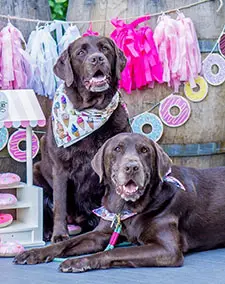Hypothermia in dogs is a serious condition where the body temperature falls below the normal range. This is most common in small shorthaired dogs – think Chihuahuas and Italian Greyhounds – but it’s possible for any dog to develop hypothermia in certain conditions.
As a certified Pet First Aid + CPR professional and a devoted dog owner, I’ve learned the importance of recognizing and addressing this issue promptly.
When treated quickly and correctly, most dogs will recover 100% from hypothermia. But it’s importnat that you take steps to prevent your dog from getting too cold and developing this dangerous condition.
In this comprehensive guide, I’ll explain how to spot the signs, prevent, and treat hypothermia in dogs, including insights from my personal experiences with my dog, Burt who got hypothermia from eating too much snow. Awareness and prompt action can make a big difference in your dog’s well-being.
This post may contain affiliate links. When you click and shop with my links I may earn a small commission that helps me keep the lights on here at Wear Wag Repeat. Thank you for your support!

Burt’s Story: My Dog Got Hypothermia from Eating Snow
Let’s rewind to a winter day a few years ago with my rescue dog, Burt. After a heavy snowfall, both of my dogs, Burt and Lucy, like many Labradors, couldn’t wait to get outside and play in the snow.
Ever the curious Labrador who has to try to eat everything, Burt was eating the snow. I didn’t think anything of it. Eating freshly fallen snow is harmless, right?
However, this seemingly harmless fun took a turn when the dogs came inside and I noticed some strange behavior from Burt.
I wouldn’t be until years later as I was getting certified in Pet First Aid + CPR that I realized how serious Burt’s condition was.
Recognizing the Signs of Hypothermia in my Dog
After Burt came inside from his snow feast, his behavior quickly changed. He vomited an intact snowball.
Yes, my dog threw up a snowball. Can you imagine how cold his internal temperature had to be in order to throw up a snowball? I’d never seen anything like it.
Then came the shivering and teeth chattering, which I later learned are classic symptoms of hypothermia.
When I adopted Burt I knew that he had epilepsy and he’s on daily medication to manage that. At this time, Burt had never had a seizure in front of me. At first I wondered if his teeth chattering was related to that.
I immediately texted one of my trusty dog friends we decided this wasn’t epilepsy related, but that I had to warm Burt up. He was experiencing hypothermia from eating snow.

Signs and Symptoms To Watch For
According to the mobile vet that we use, BetterVet, hypothermia in dogs occurs when their body temperature falls below the normal range of 101 to 102.5 degrees Fahrenheit.
Signs to watch out for include:
- Shivering and Teeth Chattering: Often the first indication of cold stress.
- Lethargy: Less activity and unwillingness to play.
- Lower Body Temperature: A drop below 99 degrees signals trouble.
I would go to the vet immediately if you notice these more severe symptoms:
- Stiff Muscles: The dog’s muscles may become rigid due to decreased circulation.
- Weak Pulse and Shallow Breathing: Indicators of the body’s struggle to maintain warmth.
- Unresponsiveness: In severe cases, the dog may become unresponsive or lose consciousness.
Act Quickly: How I Treated My Dog At Home
When I realized that Burt was experiencing hypothermia, I took action to warm him up immediately.
Quick disclaimer, when this happened to us, it was just a hunch at that he had hypothermia and I did my best to warm him up. After getting trained in pet first aid I learned that it’s best to contact your vet and possibly go in for an exam to make sure your dog is healthy and recovered from the cold.
Here’s what I did to warm up my dog Burt:
- I got him to the couch and wrapped him in blankets
- I put an electric heating pad next to him to further warm up his body temperature
- I warmed up Stella & Chewy’s bone broth and gave him some warm liquid to drink
He was very lethargic while wrapped up in the blankets. But the chattering teeth quickly stopped. By the next morning he was back to his normal self.
These actions worked to gently bring his temperature back up. Combined with close monitoring, I ensured Burt’s quick and full recovery.
This experience was a pivotal moment for me, especially later on during my training in pet first aid and CPR, where I learned more about hypothermia in dogs.

First Aid and Treatment for Hypothermic Dogs
I’m relieved to know that I took the right actions to warm up my dog. Now that I am trained in Pet First Aid I want to share with you the official recommendations for treating dogs with hypothermia at home.
If you suspect your dog has hypothermia, follow these immediate steps:
- Remove from the cold: Bring your dog indoors to a warm environment.
- Dry and warm: If wet, dry your dog gently and wrap them in warm blankets.
- Check temperature: Use a digital thermometer to monitor their temperature. This one from Mella takes an underarm temperature.
- Gradual warming: Use warm (not hot) water bottles wrapped in towels and placed next to your dog to warm them up.
- Seek Veterinary Assistance: Contact your vet immediately for further guidance and treatment.
This advice is echoed by our vet, BetterVet, in their hypothermia in dogs blog post.
By the way, if you’d like to try a mobile vet who does home visits, it’s been a game changer for us! Use my referral link to get $50 towards your first In-Home, Fear Free visit.
You can also learn more about preparing a DIY Dog First Aid Kit to be well-equipped for such emergencies. One thing I recommend is a great pet first aid book that you can reference in emergencies like this.
Preventive Steps to Protect Your Dog from Hypothermia
After my experience with Burt, I know that it’s important to take steps to prevent hypothermia. For us that means making sure Burt doesn’t eat too much snow when we’re outside in the winter!
I’m not sure how common it is to get hypothermia from eating snow, so I also want to share the more common advice for prevention. This advice is from an article our veterinarian, BetterVet, posted on their blog.
Actions to prevent hypothermia for your dog:
- Appropriate Clothing: Use dog coats or sweaters when going outside during cold weather.
- Shelter and Warmth: Ensure your dog has a warm, dry place to retreat from the cold if they are outside
- Limit Exposure: Shorten walks and outdoor activities during extremely cold weather.
- Keep your dog dry: After a wet walk or a bath, make sure to thoroughly dry your dog to prevent heat loss.
- Stay active: Regular exercise can help your dog keep their body temperature up and promote healthy circulation. If it’s too cold to exercise outside, try indoor canine enrichment games.
For more info about managing cold temperatures, check out this post I wrote about how cold is too cold for Labradors. Even if you have a dog that’s not a lab, this advice can be lifesaving!

Expert Insight: A Veterinarian’s Perspective
Dr. Joshua Montgomery, a veterinarian with our trusted BetterVet, emphasizes the importance of swift action in treating hypothermia. He notes that while home treatments can help initially, a vet visit is crucial for a thorough checkup and to address any complications.
My Personal Take: Why This Matters
My experience with Burt was a wake-up call. It made me realize the importance of being vigilant and prepared for random accidents with my dogs, especially during the colder months.
Understanding hypothermia, its signs, and how to react can be life-saving for our pets. If this happens to us again, I would follow the at-home protocol and contact our vet as soon as possible.
Empowering Dog Owners with Knowledge and Care
Having witnessed firsthand how something as simple as eating snow can lead to hypothermia, I can’t stress enough the importance of keeping a watchful eye on your dogs. Their health and safety is the most important thing.
Understanding the risks, especially with dogs prone to “eating everything” like Burt (read more about his peculiar eating habits) is crucial. Be watchful and proactive to ensure your furry friend stays safe and healthy during the winter months.
–> I’m thankful that out veterinary practice, BetterVet, shared a blog post about hypothermia in dogs and inspired me to share our story. We love having a mobile vet! If you’d like to have your veterinarian come to your home to care for your fur-family, use my referral link to get $50 towards your first In-Home, Fear Free visit.
Was this post helpful for life with your dog? Check these out:
24 Essentials in my Dog First Aid Kit
What To Do If Your Dog Chokes
The Best Toothpaste for Dogs
The Best All-Natural Dog Chews for Aggressive Chewers
How a Dog Allergy Test Can Help You Pick the Best Food For Your Dog





0 Comments